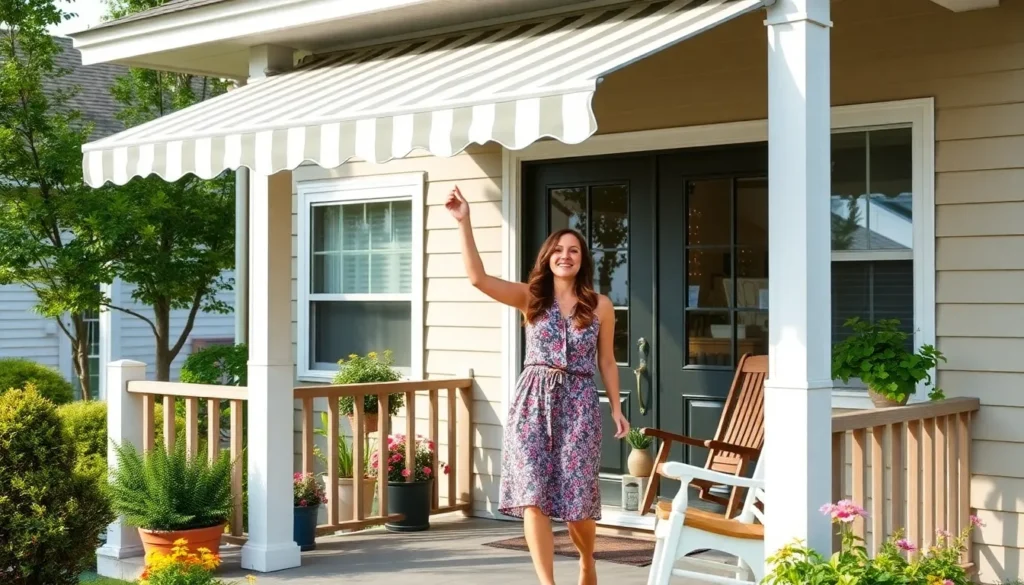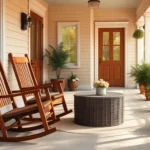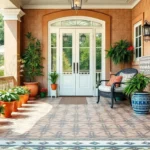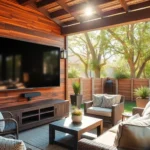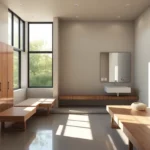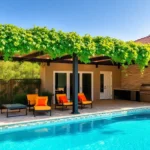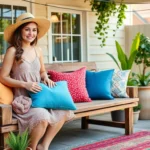Transform your front porch into an inviting outdoor retreat with the perfect awning that combines style and function. We’ve all experienced that moment when harsh sunlight or unexpected rain cuts our porch time short – but the right awning can change everything.
Front porch awnings aren’t just practical additions; they’re design statements that enhance your home’s curb appeal while creating comfortable outdoor living spaces. Whether you’re sipping morning coffee or entertaining guests we know you want a porch that works in any weather.
From retractable canvas options to permanent metal structures we’ll explore awning ideas that suit every architectural style and budget. Ready to discover how the right awning can extend your living space and boost your home’s value? Let’s jump into creative answers that’ll make your front porch the neighborhood’s favorite gathering spot.
Classic Canvas Awnings for Timeless Appeal
Canvas awnings remain our top choice for homeowners seeking that perfect blend of traditional charm and practical functionality. We’ve found that these versatile fabric answers offer the ideal balance between durability and style for any front porch design.
Traditional Striped Patterns
Striped canvas awnings bring instant character to your front porch with their vintage appeal. We recommend classic combinations like navy and white, forest green and white, or burgundy and cream for maximum curb appeal. These patterns work exceptionally well with colonial, Victorian, and cottage style homes.
Traditional awning fabrics typically feature stripes that are 4 to 6 inches wide for optimal visual impact. We’ve noticed that narrower stripes tend to look busy from a distance while wider stripes can overwhelm smaller porches. Quality canvas awnings with these classic patterns can last 8 to 12 years with proper maintenance.
Weather resistant acrylic canvas performs better than standard cotton canvas in outdoor conditions. We suggest choosing solution dyed fabrics that won’t fade quickly under UV exposure. Popular stripe combinations include hunter green with white, maroon with tan, and royal blue with cream for homes seeking that timeless aesthetic.
Solid Color Options for Modern Homes
Solid colored canvas awnings provide a sleek contemporary look that complements modern architectural styles. We often recommend neutral tones like charcoal gray, deep navy, or rich burgundy for homeowners wanting sophistication without overwhelming their home’s design elements.
Contemporary homes benefit from awnings in colors that match or complement their exterior trim and siding. We’ve seen excellent results with warm grays, sage greens, and even bold colors like terracotta or deep teal when they coordinate with the home’s color palette. These solid options create clean lines that enhance minimalist and transitional home styles.
Modern canvas awnings come in premium fabrics that offer superior fade resistance and water repellency. We prefer Sunbrella and similar high performance fabrics that maintain their appearance for 10 to 15 years. These materials resist mildew, staining, and UV damage while providing excellent sun protection for your outdoor space.
Retractable Awnings for Ultimate Flexibility
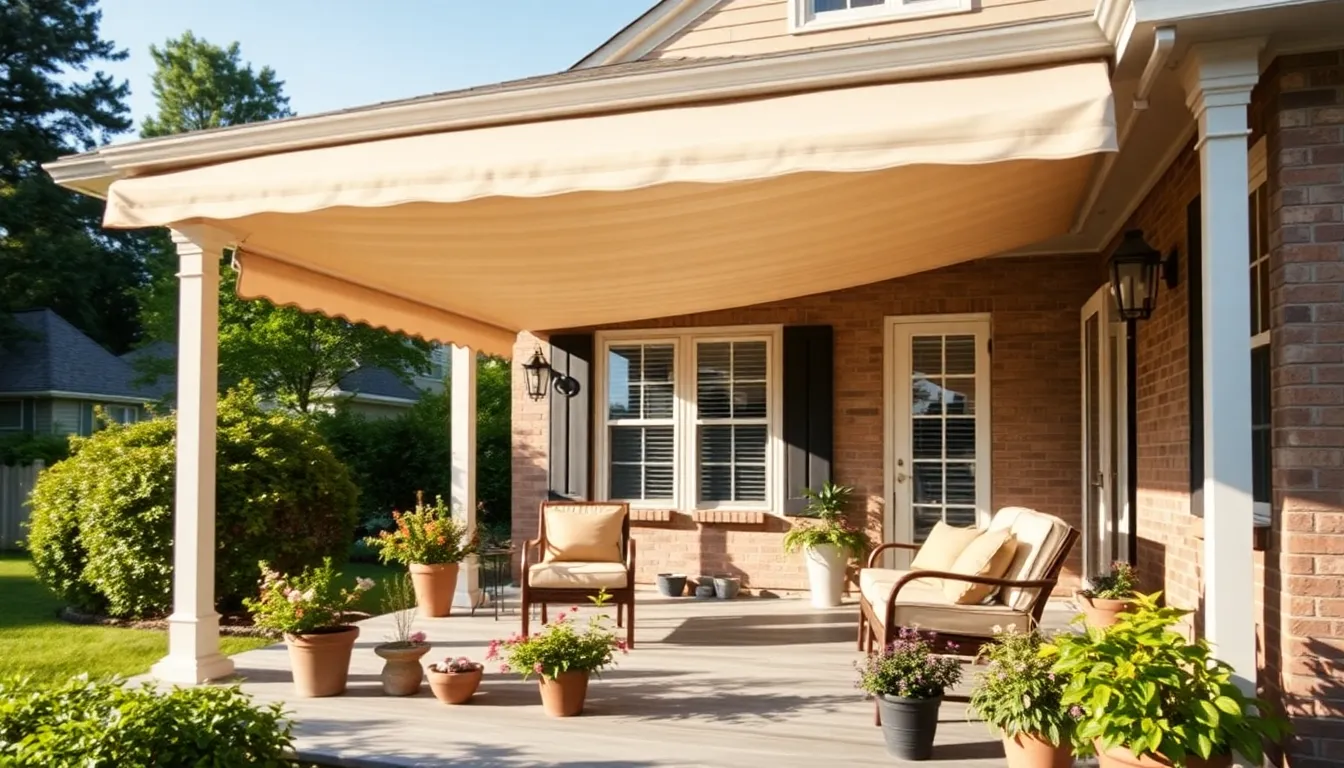
Retractable awnings give you complete control over your porch’s shade and sunlight exposure. These versatile systems extend when you need protection and retract when you want full sun or clear views.
Manual Crank Systems
Manual crank awnings offer reliable operation without electricity requirements. We recommend these cost-effective systems for homeowners who prefer hands-on control and minimal maintenance needs.
Key advantages of manual crank systems include:
- Precise control: Turn the crank handle to extend or retract your awning to the exact position you want
- Budget-friendly installation: Manual systems cost significantly less than motorized alternatives
- Zero electrical requirements: Install anywhere on your porch without worrying about power sources
- Simple maintenance: Fewer moving parts mean fewer potential repair issues over time
- Durable construction: Canvas and metal awnings with manual cranks typically last 8-12 years with proper care
Traditional hand crank mechanisms work smoothly with both lightweight canvas and heavier metal awning materials. You’ll find the operation becomes second nature after just a few uses.
Motorized Remote Control Options
Motorized awnings transform your porch experience with effortless push-button convenience. These electric systems eliminate manual labor while providing advanced protection features that manual cranks can’t match.
Motorized awnings deliver superior functionality through:
- Remote control operation: Extend or retract large awnings instantly from anywhere on your porch
- Weather sensor integration: Advanced models automatically retract during strong winds or rain to prevent damage
- Wall switch compatibility: Control your awning from inside your home with hardwired wall switches
- Solar power options: Eco-friendly models combine energy efficiency with automated convenience
- Quick adjustment capability: Perfect for extensive porch coverage areas that would be difficult to operate manually
Electric motors handle heavy-duty awnings effortlessly, making them ideal for wide porches or multiple awning installations. Weather protection sensors add an extra layer of security by reacting faster than manual operation during sudden storms.
Smart motorized systems can integrate with home automation platforms, allowing you to program automatic extension and retraction schedules based on sun position or weather forecasts.
Metal Awnings for Durability and Style
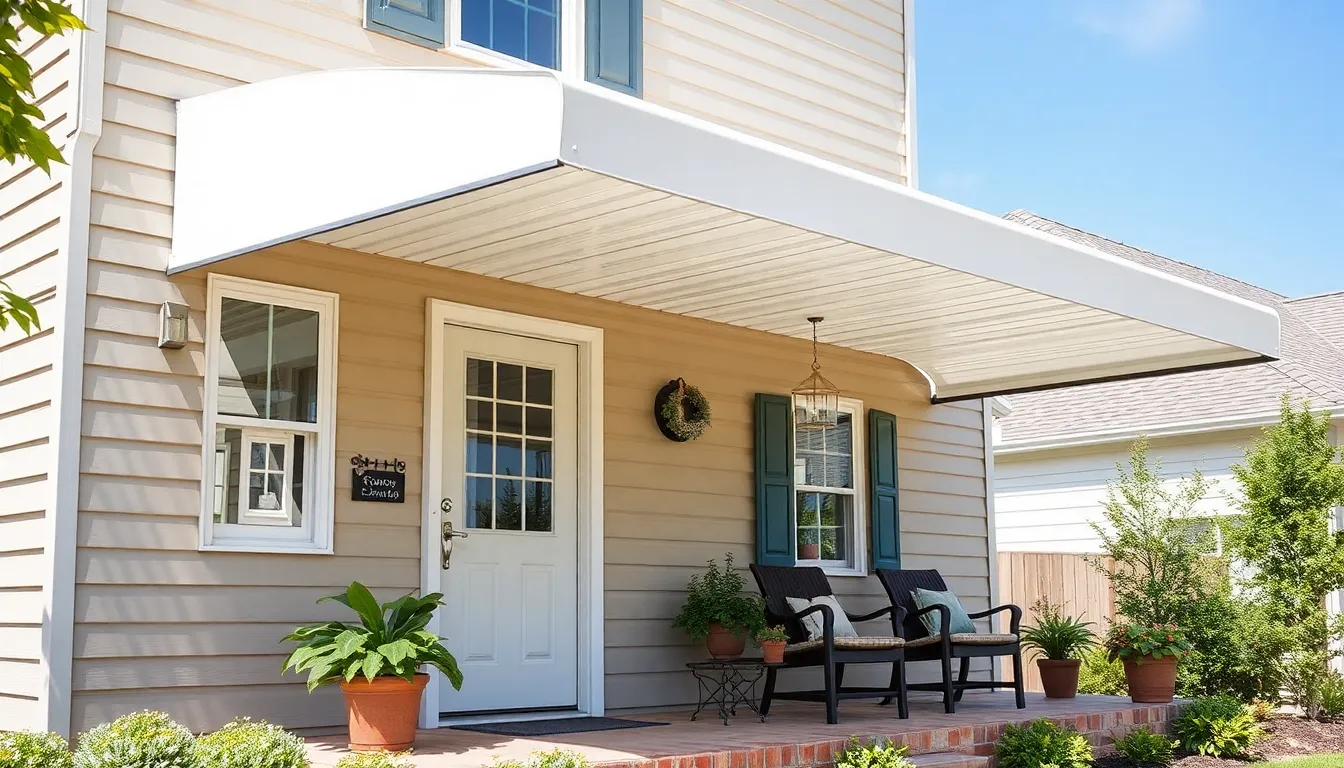
Metal awnings represent the pinnacle of porch protection, combining exceptional longevity with minimal maintenance requirements. We’ll explore why these robust structures have become increasingly popular among homeowners seeking both functionality and aesthetic appeal for their front porch awning ideas.
Aluminum Awning Benefits
Lightweight construction makes aluminum awnings incredibly easy to install while maintaining impressive structural integrity. Powder coating options allow us to customize these awnings in virtually any color, ensuring perfect coordination with your home’s exterior design scheme.
Rust resistance sets aluminum apart from other metal options, particularly in coastal areas where salt air can quickly deteriorate lesser materials. Weather resistance extends beyond corrosion protection, as aluminum naturally withstands harsh UV rays, heavy rain, and snow loads without warping or cracking.
Cost effectiveness emerges over time due to aluminum’s minimal upkeep requirements and exceptional durability. Maintenance typically involves only occasional cleaning with soap and water, eliminating the need for regular painting or fabric replacement that other awning materials demand.
Versatility in design allows aluminum awnings to complement both modern and traditional architectural styles seamlessly. Space saving installations work perfectly for smaller porches where bulky structures might overwhelm the space.
Steel Frame Constructions
Structural strength defines steel frame awnings, providing unmatched stability during severe weather conditions including high winds and heavy snow loads. Engineering specifications for steel frames typically exceed those of other materials, making them ideal for larger awning installations.
Weather resistance reaches exceptional levels when steel frames support aluminum panels or fabric covers, creating a hybrid system that maximizes both durability and functionality. Strong wind resistance becomes particularly important in areas prone to storms or consistent gusty conditions.
Installation versatility allows steel frames to accommodate various awning materials, from metal panels to canvas fabrics, giving us multiple design options while maintaining superior structural support. Robust construction ensures these frames can handle the weight and stress of different covering materials without compromising safety.
Enhanced safety results from steel’s superior load bearing capacity, providing peace of mind for families who regularly use their covered porch spaces. Stability under pressure makes steel framed awnings an excellent long term investment for front porch enhancement projects.
Pergola-Style Awnings for Natural Shade
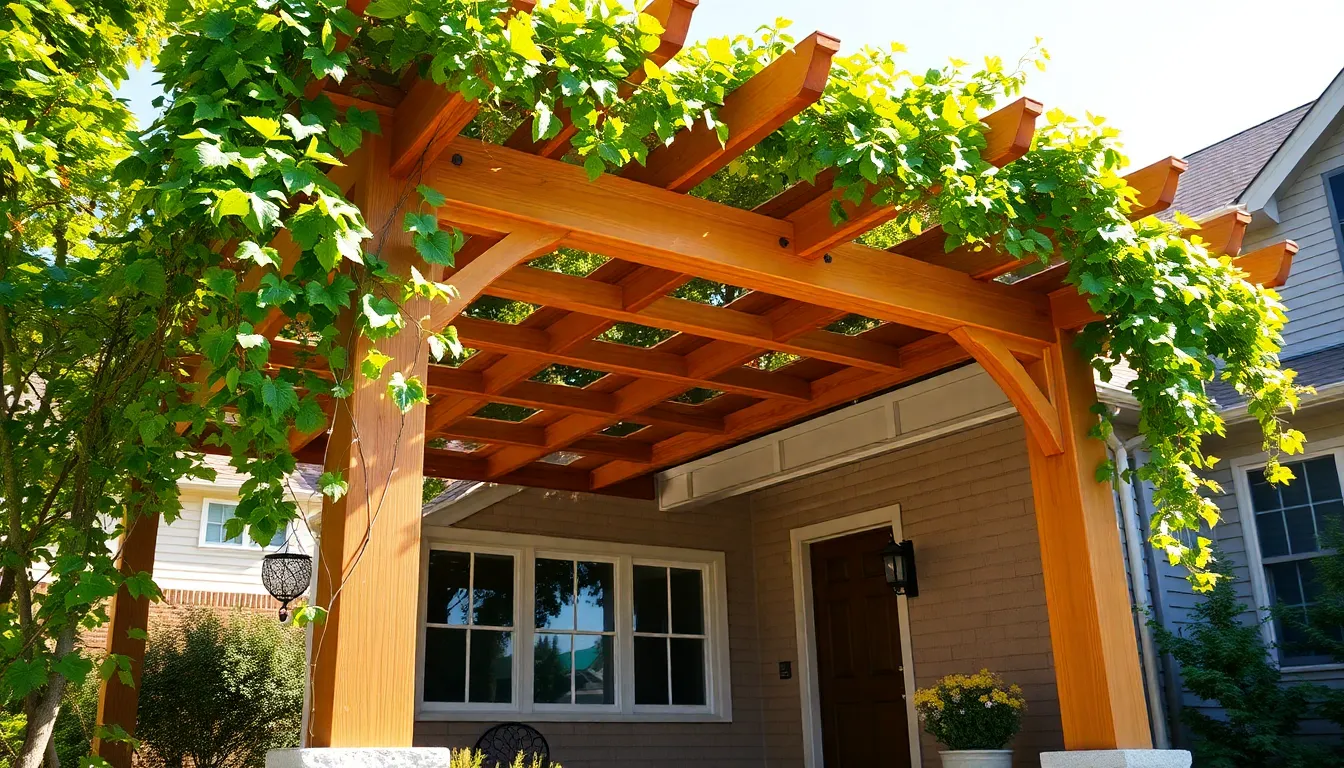
Pergola awnings transform your front porch into an architectural masterpiece while delivering functional natural shade through their distinctive open lattice framework. This design allows sunlight to filter through beautifully, creating partial shelter that enhances both comfort and visual appeal.
Wooden Pergola Awnings
Wooden pergola awnings bring timeless warmth and rustic charm to any front porch design. Natural wood offers incredible versatility since you can stain or paint it to match traditional or contemporary home styles perfectly. These structures provide durable shade coverage while accommodating drapes or retractable fabric covers for additional flexibility.
Customization becomes effortless with wooden pergolas as their natural texture complements diverse architectural themes. Climbing vines and plants integrate seamlessly with the wood framework, creating a cozy and inviting atmosphere. Weather resistance improves significantly when you choose quality wood treatments and proper installation techniques.
Vinyl and Composite Materials
Vinyl awnings deliver exceptional durability with minimal maintenance requirements for busy homeowners. These weather resistant materials resist moisture, fading, and pest damage while mimicking wood textures and other natural appearances convincingly. Installation costs often balance out through reduced long term upkeep expenses.
Composite materials blend synthetic fibers with wood fibers to achieve enhanced strength and natural aesthetics simultaneously. Longevity becomes a major advantage since these materials withstand harsh weather conditions without warping, cracking, or rotting like traditional wood. Maintenance involves simple cleaning rather than annual staining or painting projects.
Flexibility in design allows both vinyl and composite pergola awnings to accommodate various climbing plants and fabric additions. Weather conditions rarely affect the structural integrity of these modern materials, making them ideal for regions with extreme temperature fluctuations or high humidity levels.
Fixed Canopy Awnings for Permanent Protection
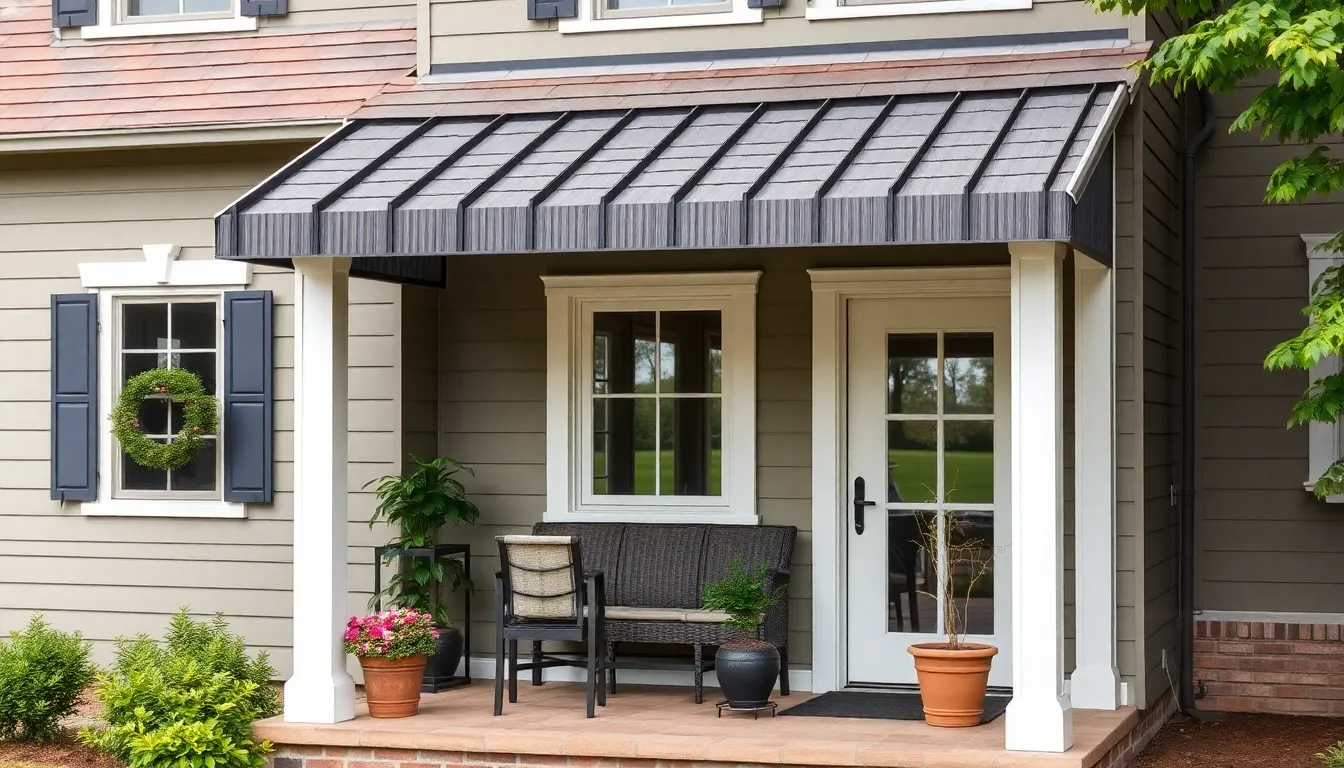
Fixed canopy awnings offer the most durable solution for front porch protection, creating a permanent shelter that withstands weather year-round. These structures use robust materials like metal frames with polycarbonate or fabric covers designed to resist rain, snow, and UV rays.
Hip Roof Style Canopies
Hip roof canopies mirror traditional hip roof designs with slopes on all four sides, creating a sophisticated look that complements various home architectures. This classic style blends seamlessly with colonial, craftsman, and Victorian homes while providing exceptional water runoff capabilities.
We recommend hip roof canopies for homeowners seeking timeless elegance combined with superior weather protection. The four-sided slope design ensures excellent drainage, preventing water pooling that could damage the structure over time. These canopies typically feature wood or metal frames covered with roofing materials like shingles or metal sheets that match your house’s existing roof.
Construction costs vary depending on materials, but hip roof canopies deliver long-term value through their durability and architectural appeal. The multi-slope design creates a cozy, sheltered feeling on your porch while maintaining visual harmony with your home’s overall design aesthetic.
Shed Style Fixed Awnings
Shed style awnings feature a single sloping plane that angles downward from the house, offering a modern and streamlined appearance. This simpler structure costs less to install than hip roof designs while still providing important coverage and protection.
We find shed awnings particularly versatile because they work well with contemporary, ranch, and minimalist home styles. The single slope design effectively channels rainwater away from the porch while creating clean, geometric lines that enhance modern architectural features.
Materials for shed style awnings include wood, metal, or high-performance fabric stretched over sturdy frames. Metal frame options with polycarbonate covers can withstand winds up to 55 mph while blocking harmful UV rays and allowing natural light to filter through.
These awnings prove economical for smaller porches or as budget-conscious permanent answers that boost both functionality and curb appeal. Installation typically takes less time than complex multi-slope designs, making shed style awnings an efficient choice for quick porch transformations.
Dome and Curved Awnings for Architectural Interest

We’re showcasing curved awning designs that bring distinctive architectural appeal to your front porch while delivering superior weather protection.
Quarter Circle Dome Designs
Quarter circle dome awnings create a softly rounded canopy that gracefully extends from your porch or entryway. These elegant sculptural elements add visual interest to your home’s facade while providing complete coverage from sun and rain. Their unique geometric form balances modern sophistication with timeless appeal, making them suitable for various architectural styles.
Constructed from durable weather resistant materials, these dome shapes maintain their structural integrity through harsh weather conditions. We recommend quarter circle designs for homeowners seeking a distinctive look that doesn’t overwhelm smaller porch spaces. Their gentle curves complement both contemporary and traditional home exteriors while creating an inviting entrance that enhances curb appeal.
Barrel Vault Curved Options
Barrel vault awnings feature an elongated curved shape resembling half a cylinder or barrel. This dramatic architectural element significantly enhances porch depth and character while offering ample shade coverage. Their striking visual profile makes them ideal for larger porches where bold design statements are desired.
Available in both fabric and metal construction options, barrel vault awnings can be customized to match your home’s exterior aesthetic. Metal versions provide long term durability with minimal maintenance requirements, while fabric options offer softer visual appeal with various color and pattern choices. We’ve found that barrel vault designs work exceptionally well with Mediterranean, modern, and craftsman style homes where their dramatic curves complement existing architectural features.
DIY Awning Ideas for Budget-Conscious Homeowners
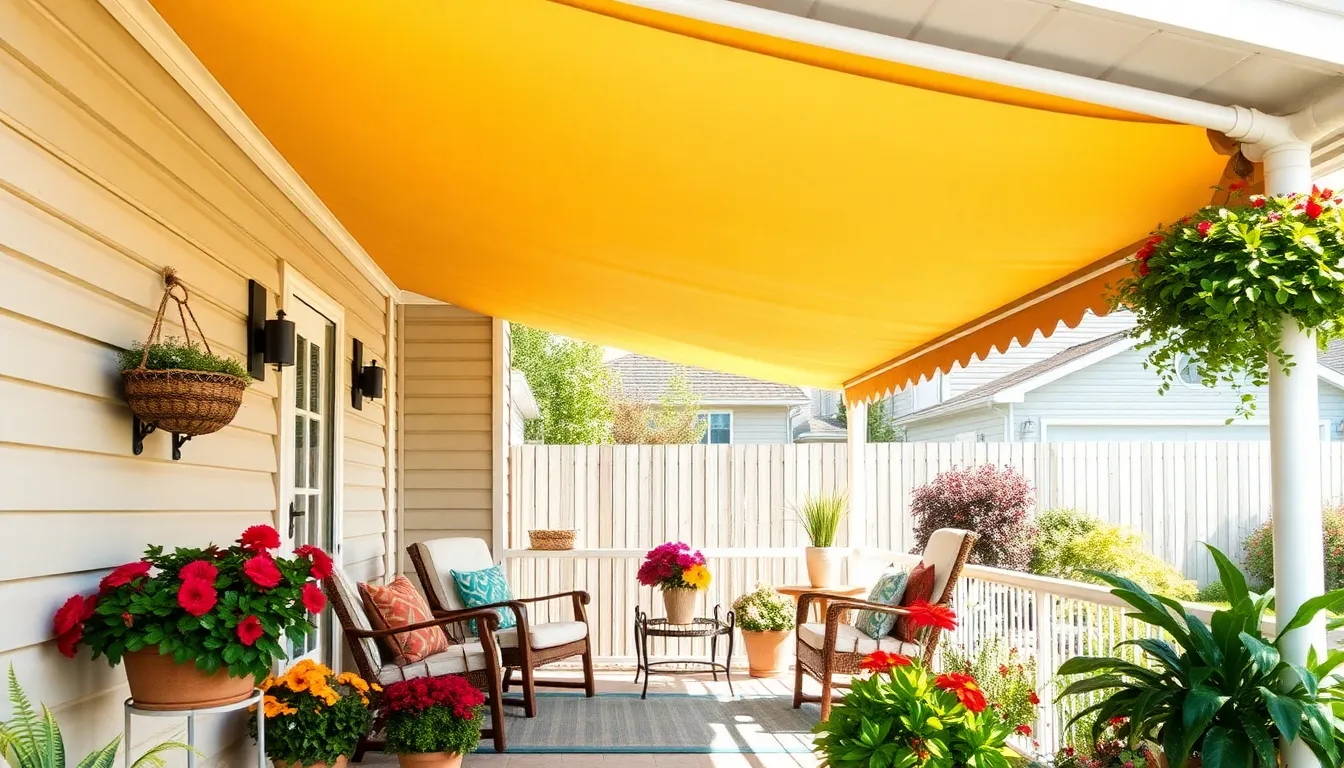
Creating beautiful front porch shade doesn’t require very costly. We’ll explore affordable DIY answers that deliver both function and style using accessible materials and straightforward construction methods.
Drop Cloth and PVC Pipe Projects
Canvas drop cloths paired with PVC pipes create surprisingly effective awnings at a fraction of traditional costs. We recommend starting with heavy duty canvas drop cloths that measure at least 9×12 feet for adequate porch coverage.
PVC pipe frames provide the structural foundation for these budget friendly awnings. Standard 1 inch PVC pipes work best for most residential applications, offering sufficient strength while remaining lightweight and easy to handle. The modular nature of PVC components allows for complete customization based on your porch dimensions.
Assembly involves connecting PVC joints to create a rectangular or angled frame that supports the canvas covering. We suggest using PVC cement at all connection points to ensure durability against wind and weather exposure. The lightweight construction makes installation manageable for most homeowners without requiring professional assistance.
Mounting options include attaching brackets directly to porch columns or house siding using galvanized screws. Canvas drop cloths can be secured to the PVC frame using grommets and zip ties for a clean, professional appearance. This combination typically costs under $100 for materials, making it one of the most economical awning answers available.
Outdoor Fabric and Hardware Answers
Weather resistant outdoor fabrics designed specifically for awning applications significantly outperform standard indoor materials. We recommend investing in UV blocking outdoor fabric that can withstand rain, snow, and continuous sun exposure without fading or deteriorating.
Polycarbonate covers offer excellent durability when combined with metal frame systems. These transparent or tinted panels transmit natural light while blocking harmful UV rays and providing superior wind resistance compared to fabric options. Installation typically involves securing panels to aluminum or steel frames using specialized mounting hardware.
Hardware selection plays a crucial role in DIY awning longevity and performance. Stainless steel brackets, galvanized bolts, and marine grade fasteners resist corrosion and maintain structural integrity across multiple seasons. We suggest purchasing hardware rated for outdoor use to avoid premature failure and costly replacements.
Pre drilled mounting systems simplify installation for homeowners with basic DIY skills. Many outdoor fabric awning kits include all necessary hardware and detailed instructions for weekend installation projects. Optional mounting brackets allow for adjustments and customization based on exact porch configurations and aesthetic preferences.
Metal frames combined with quality outdoor fabrics create durable fixed awnings suitable for year round use. This approach handles heavy weather conditions while requiring minimal ongoing maintenance, making it ideal for homeowners seeking long term value from their DIY investment.
Awning Materials and Fabric Choices
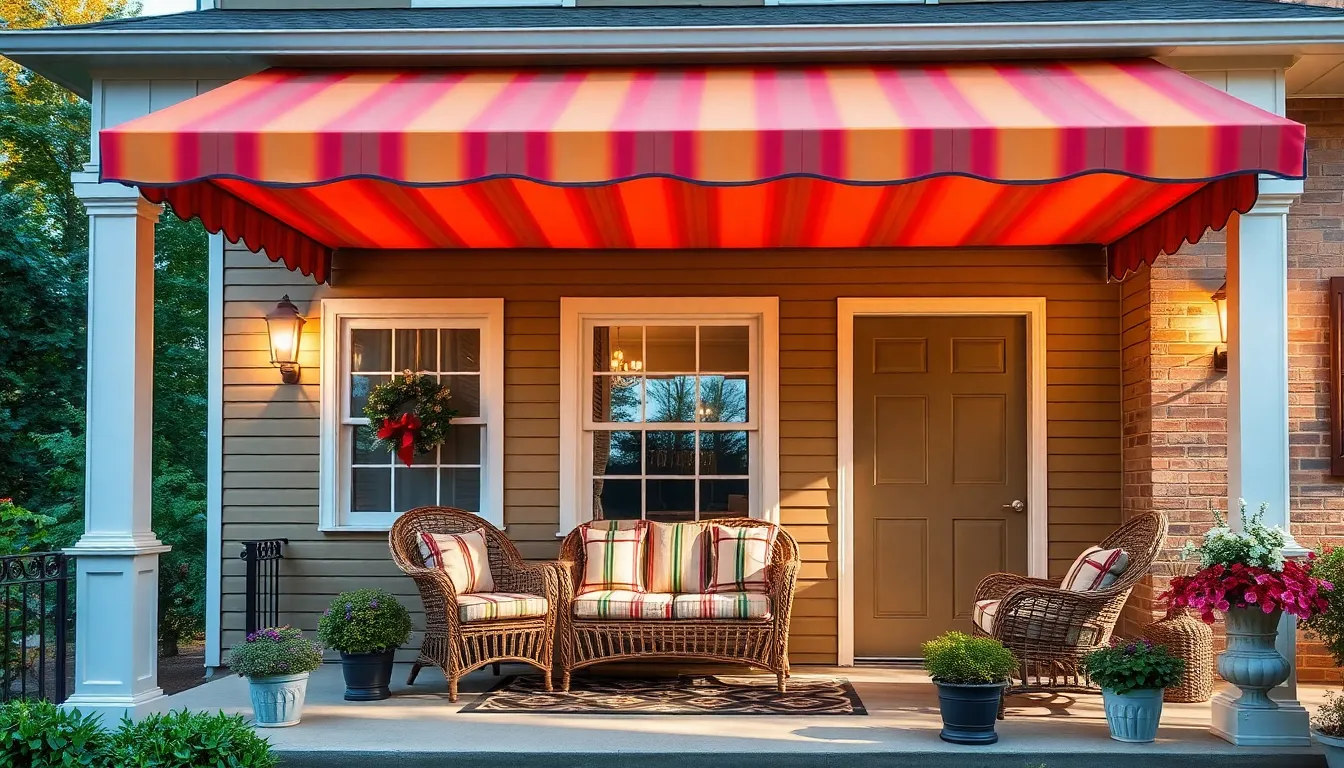
Selecting the right materials and fabrics for your front porch awning directly impacts both its longevity and performance. We’ll explore the most durable options that combine style with weather resistance.
Weather-Resistant Fabric Options
Acrylic fabrics stand as our top recommendation for porch awnings due to their exceptional resistance to fading, mildew, and moisture absorption. These materials maintain their color vibrancy even after years of sun exposure while effectively repelling water to prevent damage.
Polyester fabrics with PVC coating offer an excellent balance of waterproofing and flexibility for homeowners seeking reliable protection. This combination enhances the fabric’s ability to shed water while maintaining its structural integrity through temperature changes and weather fluctuations.
Zipline fabric provides a nautical inspired solution that withstands harsh elements while allowing quick adjustments for optimal shade and airflow. This robust material excels in coastal environments or areas with frequent weather changes.
Bamboo weave awnings create an eco friendly alternative by weaving bamboo stalks into intricate patterns that naturally provide coolness and shade. These sustainable options work particularly well for homes with natural or tropical design themes.
Canvas fabrics remain popular choices for their versatility and aesthetic appeal, coming in various textures and weights to suit different architectural styles. We recommend choosing canvas that’s been specifically treated for outdoor use to maximize durability.
UV Protection and Waterproof Coatings
UV blocking coatings protect both your awning fabric and the porch area beneath from harmful sun damage while significantly extending the material’s lifespan. These specialized treatments prevent fabric deterioration and color fading that typically occurs with prolonged sun exposure.
Polyurethane coatings create a flexible waterproof barrier that repels water while allowing the fabric to move naturally with wind and weather conditions. This coating type works exceptionally well on acrylic and polyester fabrics.
PVC coatings offer heavy duty waterproofing for awnings in areas with frequent rainfall or high humidity levels. These coatings prevent mold and mildew growth while maintaining the fabric’s breathability and appearance.
Solar powered awning systems integrate UV protective fabrics with energy harvesting technology, providing shade while generating power for your home. These advanced options include water resistant solar panels that maintain functionality even during light rain.
Eco friendly protective treatments use plant based compounds to create water and UV resistance without harmful chemicals. These sustainable coatings appeal to environmentally conscious homeowners while delivering comparable protection to traditional treatments.
Color and Pattern Combinations for Curb Appeal
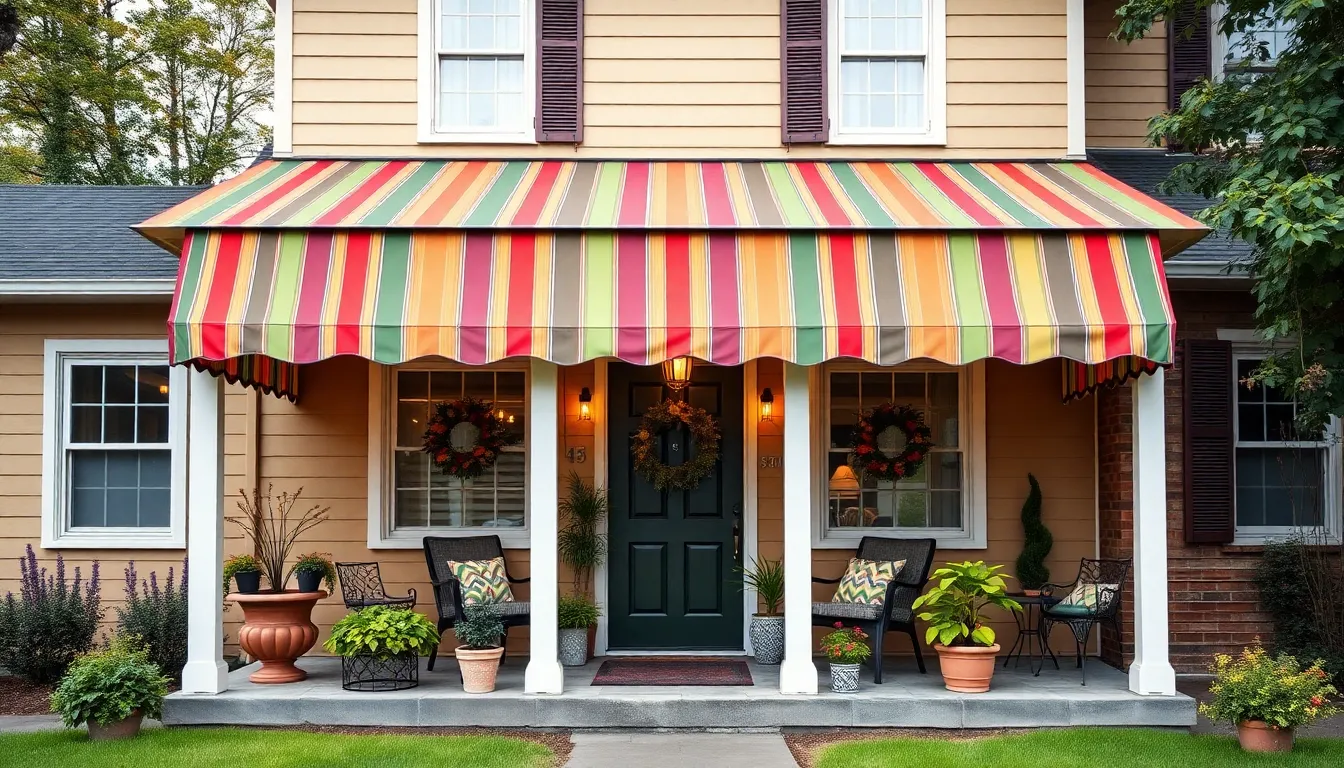
Selecting the perfect color and pattern combination transforms your front porch awning from a simple shade solution into a stunning architectural accent that elevates your home’s entire exterior appeal.
Coordinating with Home Exterior Colors
Harmonizing your awning colors with your home’s primary exterior creates a cohesive and inviting appearance that feels intentionally designed. Earth tone homes benefit tremendously from awnings in neutral or complementary shades like beige, olive, or taupe that blend seamlessly with the natural color palette. Brighter exterior homes often shine when paired with bold awning colors that provide striking contrast and effectively highlight unique architectural features.
We recommend analyzing your home’s dominant color family before making your final selection. Warm exterior tones pair beautifully with awnings in rust, burgundy, or deep green shades. Cool colored homes look stunning with awnings in navy blue, forest green, or charcoal gray options. Testing color combinations through samples or digital visualization tools helps ensure your chosen awning enhances rather than clashes with your existing exterior palette.
Bold Patterns vs. Neutral Tones
Bold patterns like black and white stripes deliver timeless and striking visual appeal that works exceptionally well with Tuscan, Mediterranean, or colonial architectural styles. These classic stripe combinations add sophisticated elegance and create compelling visual interest that draws the eye upward to your porch area. Pattern selection significantly impacts your home’s overall aesthetic, with geometric designs offering modern flair and traditional stripes providing enduring charm.
Neutral tones provide versatile and subtle backdrops that complement various architectural styles without overwhelming your home’s facade. Solid colors in beige, cream, or soft gray create clean lines that enhance contemporary homes while maintaining classic appeal for traditional designs. We find that neutral awnings allow other architectural elements like shutters, trim, or landscaping to take center stage while still providing necessary function and style.
Choosing between bold patterns and neutral tones depends largely on your home’s existing visual complexity and personal style preferences. Busy exteriors with multiple colors or textures benefit from solid, neutral awnings that provide visual rest. Simpler home designs can accommodate bolder patterns that add personality and create focal points that enhance curb appeal dramatically.
Installation and Maintenance Considerations
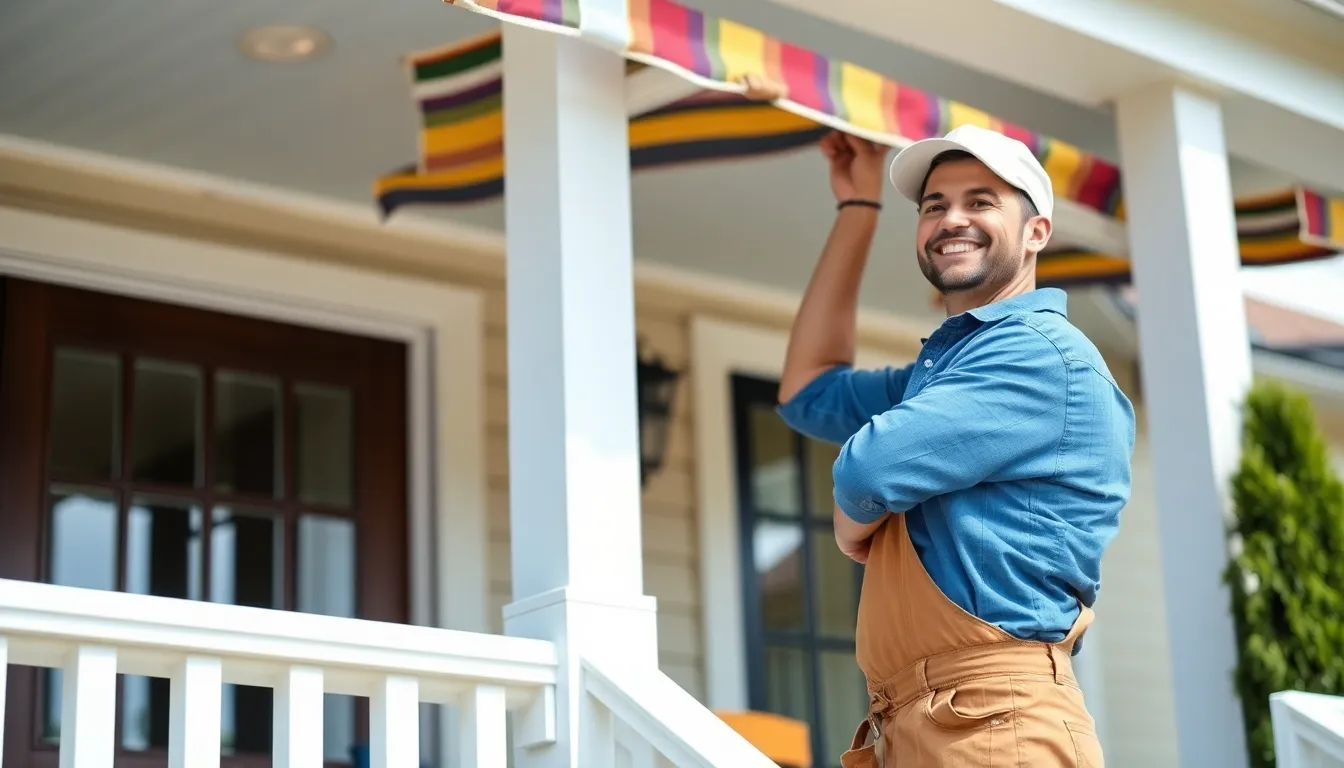
Once you’ve selected the perfect awning style and materials for your front porch, proper installation and ongoing care will ensure years of reliable performance and visual appeal.
Professional Installation vs. DIY Setup
Professional installation becomes essential when dealing with complex or motorized awning systems that require secure mounting and electrical connections. Professionals can properly fasten mounting brackets and handle the exact adjustments needed for optimal performance and durability, ensuring your investment operates safely for years to come.
DIY installation offers a cost-effective solution for many standard retractable or fixed awnings, allowing homeowners to save significantly on labor costs. Key steps we recommend include:
- Preparing the installation site and determining the proper mounting height for optimal shade coverage
- Installing support brackets securely using appropriate screws and power tools
- Lifting the awning onto the brackets with assistance and locking it firmly in place
- Testing the awning’s operation thoroughly and making necessary adjustments to alignment or slope
- Following manufacturer instructions carefully to avoid damage or voiding warranty coverage
Seasonal Care and Cleaning Tips
Regular cleaning with mild soap and water maintains your awning’s appearance while preventing mold buildup and fabric deterioration. We advise avoiding harsh chemicals or abrasive cleaning tools that can damage fabric fibers and protective coatings.
Pressure washing can be effective when you hold the nozzle at least two feet away from the fabric surface to minimize potential damage during rinsing. This distance helps preserve the fabric’s integrity while removing stubborn dirt and debris.
Weather protection requires retracting or securing your awning during severe conditions like strong winds, heavy rain, snow, or extreme heat. For example, we recommend avoiding grilling operations directly under fabric awnings to prevent heat damage and potential fire hazards.
Hardware inspection should occur regularly to check for loose screws, bolts, or nuts, while examining fabric sections for holes, tears, or excessive wear. Tightening hardware and addressing fabric issues promptly ensures safety and extends your awning’s operational life.
Moisture management means never retracting wet awnings, as this practice can lead to mildew growth and mechanical problems that compromise the system’s functionality. Also, lubricating moving parts according to manufacturer specifications keeps mechanisms operating smoothly and prevents premature wear.
Following these installation and maintenance guidelines can help your front porch awning provide reliable service for up to 15 years while maintaining its attractive appearance and protective benefits.
Conclusion
We’ve explored many front porch awning options that can transform your outdoor space into a stylish and functional retreat. From classic canvas designs to modern retractable systems and durable metal structures each option offers unique benefits to match your home’s architecture and budget.
The key to success lies in choosing materials that balance aesthetics with durability while considering your local climate conditions. Whether you opt for a DIY solution or professional installation proper maintenance will ensure your awning provides years of reliable service.
Your front porch awning investment extends beyond mere functionality—it’s an opportunity to enhance curb appeal create an inviting gathering space and potentially increase your home’s value. We’re confident these ideas will help you create the perfect outdoor retreat that welcomes family and friends while protecting them from the elements.
Frequently Asked Questions
What are the main benefits of adding an awning to my front porch?
Awnings provide essential shelter from harsh sunlight and rain, making your outdoor space more comfortable and usable. They significantly enhance your home’s curb appeal while offering practical protection. Beyond functionality, awnings can increase your property value and create an inviting outdoor retreat that becomes a popular gathering spot.
How long do canvas awnings typically last?
Canvas awnings can last 8 to 12 years with proper maintenance. The longevity depends on the fabric quality and weather conditions. Weather-resistant acrylic fabrics like Sunbrella offer superior fade resistance and durability, potentially extending the lifespan. Regular cleaning and proper care can help maximize your awning’s lifespan.
What’s the difference between manual and motorized retractable awnings?
Manual crank awnings are budget-friendly, reliable, and require minimal maintenance, operated by a simple hand crank system. Motorized awnings offer convenience with remote control operation, weather sensor integration, and compatibility with home automation systems. While motorized options cost more upfront, they provide enhanced convenience and advanced features.
Which awning material requires the least maintenance?
Metal awnings, particularly aluminum, require the least maintenance due to their rust resistance and durability. Vinyl and composite materials are also low-maintenance options that resist moisture and fading. These materials can withstand harsh weather conditions without frequent upkeep, making them ideal for homeowners seeking minimal maintenance solutions.
Can I install an awning myself or do I need professional help?
Simple canvas and standard awnings can often be DIY projects using basic materials and tools. However, complex systems like motorized retractable awnings or large metal installations benefit from professional installation. DIY options using materials like canvas drop cloths and PVC pipes can be cost-effective for budget-conscious homeowners.
What colors and patterns work best for front porch awnings?
Choose colors that complement your home’s exterior for a cohesive look. Earth tones work well with natural palettes, while bold colors suit brighter homes. Classic stripe combinations like navy and white or burgundy and cream are timeless choices. Consider your home’s existing visual complexity when deciding between bold patterns and neutral tones.
How do I maintain my awning to ensure longevity?
Regular cleaning and hardware inspections are essential for awning longevity. Clean fabric awnings with mild soap and water, allowing them to dry completely before retracting. Check mounting hardware, adjust tension as needed, and inspect for wear or damage. Proper maintenance can extend your awning’s life up to 15 years.
Are there eco-friendly awning options available?
Yes, eco-friendly options include bamboo weave awnings and fabrics with environmentally conscious treatments. Solar-powered awning systems integrate energy harvesting technology for sustainable operation. Many manufacturers now offer eco-friendly treatments and materials that appeal to environmentally conscious homeowners while maintaining durability and performance.

